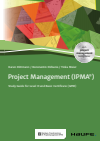Project Management (IPMA®)
Study Guide for Level D and Basic Certificate (GPM)
Zusammenfassung
This book contains the complete learning scope for the certification to IPMA® Level D, as well as the scope for obtaining the Basic Certificate. It offers numerous examples and templates for project management methods and practical tips. It also aims to show that professionally executed project management can actually be enjoyable and is probably one of the most versatile and exciting professions imaginable.
The IPMA® (International Project Management Association) defines standards for professional project management worldwide. With its five-level model, it provides the certification framework for project managers, with a strong focus on its transfer into the daily routine of project management. The approach does not limit itself to procedures and process models but covers all competencies important for project management.
Contents:
Defining the terms, standards and types of projects
Corporate culture and values in projects
Personal and social skills for project managers
Methodical-technical know-how for projects: initialization, planning, requirements and goals, control, completion
Abstract
This book contains the complete learning scope for the certification to IPMA® Level D, as well as the scope for obtaining the Basic Certificate. It offers numerous examples and templates for project management methods and practical tips. It also aims to show that professionally executed project management can actually be enjoyable and is probably one of the most versatile and exciting professions imaginable.
The IPMA® (International Project Management Association) defines standards for professional project management worldwide. With its five-level model, it provides the certification framework for project managers, with a strong focus on its transfer into the daily routine of project management. The approach does not limit itself to procedures and process models but covers all competencies important for project management.
Contents:
Defining the terms, standards and types of projects
Corporate culture and values in projects
Personal and social skills for project managers
Methodical-technical know-how for projects: initialization, planning, requirements and goals, control, completion
- 1–12 Titelei/Inhaltsverzeichnis 1–12
- 13–32 1 Competence Area: Perspective 13–32
- 1.1 CE Strategy (4.3.1)
- 1.2 CE Governance, Structure, and Processes (4.3.2)
- 1.2.1 Definition: Project
- 1.2.2 Definition: Project Management
- 1.2.3 Project Management Standards
- 1.2.4 Project Types
- 1.2.5 Project Management Manual
- 1.2.6 Project Portfolio
- 1.3 CE Compliance, Standards and Regulations (4.3.3)
- 1.3.1 Identify and Ensure that the Project Complies with All Relevant Legislation
- 1.3.2 Data Protection and Data Security
- 1.3.3 Safety, Health, and Environmental Regulations
- 1.3.4 Hazard Analysis/Risk Assessment
- 1.4 CE Power and Interests (4.3.4)
- 1.4.1 Definition of Power
- 1.4.2 Authorization and Motivation
- 1.4.3 The Pyramid of Needs (Maslow)
- 1.4.4 Analysis of Interests
- 1.5 CE Culture and Values (4.3.5)
- 1.5.1 Align the Project with the Formal Culture and Corporate Values of the Organization
- 33–90 2 Competence Area: People 33–90
- 2.1 CE Self-Reflection and Self-Management (4.4.1.)
- 2.1.1 Eisenhower Matrix
- 2.1.2 Reflecting on Your Own Team Role
- 2.1.3 The Johari Window
- 2.1.4 Personal Development of Competence in Project Management
- 2.2 CE Personal Integrity and Reliability (4.4.2)
- 2.2.1 Reliability and Trust
- 2.2.2 Fault Culture
- 2.3 CE Personal Communication (4.4.3)
- 2.3.1 The Iceberg Model: Content and Relationship Aspects
- 2.3.2 Communication Channels and Disruptions
- 2.3.3 Receiving Information: Active Listening
- 2.3.4 The Art of Asking: Interview Techniques
- 2.3.5 Feedback
- 2.3.6 Meetings
- 2.3.7 Communicating Effectively in Virtual Teams
- 2.4 CE Relationships and Engagement (4.4.4)
- 2.5 CE Leadership (4.4.5)
- 2.5.1 Leadership Styles
- 2.5.2 Management Concepts
- 2.6 CE Teamwork (4.4.6)
- 2.6.1 Stages of Team Development (Tuckman)
- 2.6.2 Team Rules
- 2.6.3 Team Roles (Belbin)
- 2.7 CE Conflict and Crisis (4.4.7)
- 2.7.1 Definition: Conflict and Crisis
- 2.7.2 Symptoms of Conflict
- 2.7.3 Causes of Conflict
- 2.7.4 Conflict Styles
- 2.8 CE Resourcefulness (4.4.8)
- 2.8.1 Moderation Techniques to Stimulate an Open and Creative Environment
- 2.8.2 Analytical Techniques to Analyze Data and Situations
- 2.8.3 Creativity Techniques to Solve Problems
- 2.9 CE Negotiation (4.4.9)
- 2.10 CE Results Orientation (4.4.10)
- 2.10.1 Results Orientation in Project Management
- 2.10.2 Requirements for the Project Manager
- 2.10.3 Guidelines to Results Orientation
- 2.10.4 Results Orientation in Practice
- 91–226 3 Competence Area: Practice 91–226
- 3.1 Initialization
- 3.1.1 Documents in the Initialization and Definition Phase
- 3.2 Definition
- 3.2.1 CE Project Design (4.5.1)
- 3.2.2 Phase Planning
- 3.2.3 Start the Project and Achieve Commitment
- 3.2.4 CE Organization (4.5.5)
- 3.2.5 CE Stakeholders (4.5.12)
- 3.2.6 CE Information and Documentation (4.5.5)
- 3.2.7 CE Risk and Opportunity (4.5.11)
- 3.2.8 CE Requirements and Objectives (4.5.2)
- 3.3 Planning
- 3.3.1 CE Scope (4.5.3)
- 3.3.2 CE Time (4.5.4)
- 3.3.3 CE Resources (4.5.8)
- 3.3.4 CE Finance (4.5.7)
- 3.4 Steering
- 3.4.1 CE Plan and Control (4.5.10)
- 3.4.2 Assess, Agree, and Implement Changes
- 3.4.3 CE Quality (4.5.6)
- 3.4.4 Progress Measurement
- 3.4.5 Manage Transition into a New Phase
- 3.4.6 Reports
- 3.4.7 CE Procurement (4.5.9)
- 3.4.8 CE Change and Transformation (4.5.13)
- 3.5 Closure
- 3.5.1 Project Evaluation and Lessons Learned
- 3.5.2 Acceptance
- 227–228 Abbreviations 227–228
- 229–229 Acknowledgements 229–229
- 230–230 About the Authors 230–230
- 231–231 References 231–231
- 232–239 Index 232–239


